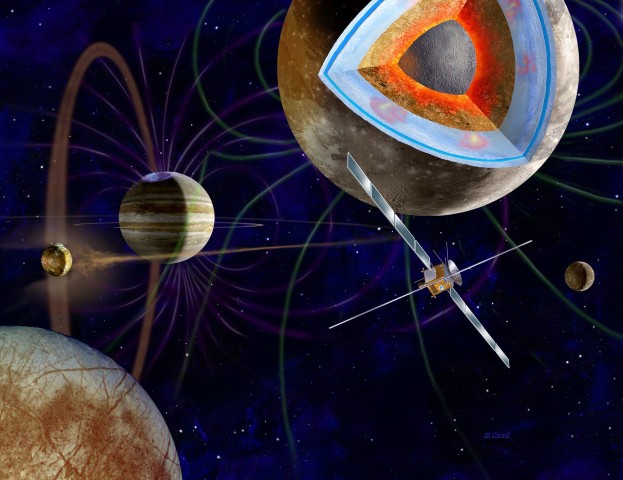Exploration
Discussed earlier were the previous missions to Europa, the one voyager fly by and the Galileo missions.
 |
Image credit: JPL/NASA |
Launched in 1977, the twin spacecraft of the Voyager Mission's primary objective was the exploration of Jupiter and Saturn. They were a success, and made a string of discoveries, including volcanoes on Io and details about Saturn's rings. Among these many discoveries was the youthful face of Europa, as discussed in the Ocean section. Pictured to the left is computer model of the Voyager 2 spacecraft in front of Jupiter. While the primary mission of the spacecraft is complete, they have now continued on to an interstellar mission and continue to transmit data.
 |
Image credit: JPL/NASA |
The Galileo mission was launched in 1989. Its primary mission was to send an atmospheric probe into Jupiter's atmosphere, and then study the gas giant and its satellites. Prior to even reaching Jupiter, the spacecraft flew by and studied two asteroids and Venus. After completing its originally planned trajectory, the mission was extended to study Europa more closely. In total, the spacecraft flew by Europa 11 times, Callisto and Ganymede 8 each, and Io 7. In 2003, the spacecraft was sent to its fiery death in Jupiter's atmosphere. Nearly the entire basis for our current knowledge of the Jovian comes from the Galileo mission. The picture to the right is of the Galileo spacecraft.
For future missions, there is the ESA's JUICE and NASA's Clipper mission.
 |
Image credit: ESA |
The ESA (European Space Agency) JUICE (JUpiter ICy moons Explorer) mission is expected to launch in 2022. Its primary mission is divided into two parts. First, it is to explore the potentially habitable satellites: Ganymede, Callisto, and Europa. Second, it will characterize Jupiter's atmosphere, magnetosphere, and smaller satellites and rings. Its primary focus is actually Ganymede which like Europa, harbors potential for life, although it is believed that Ganymede's oceans are layers of alternating ice and liquid. Pictured to the left is conceptual art of the JUICE mission.
 |
NASA's Clipper mission is Europa specific. The mission is still in its proposal stage, so there is no official launch date and little details available to the public. However, current plans include a total of 45 flybys of Europa. Being specialized for Europa allows the spacecraft to make much closer fuel-efficient flybys (some as close as 16 miles). Some of the instruments that would likely be included are radar to penetrate the surface and determine the thickness of the icy crust, an infrared spectrometer to investigate the surface, a topographic camera for high resolution imaging, and an ion and nuetral mass spectrometer to investigate the atmosphere. The image to the right is conceptual art for the mission.